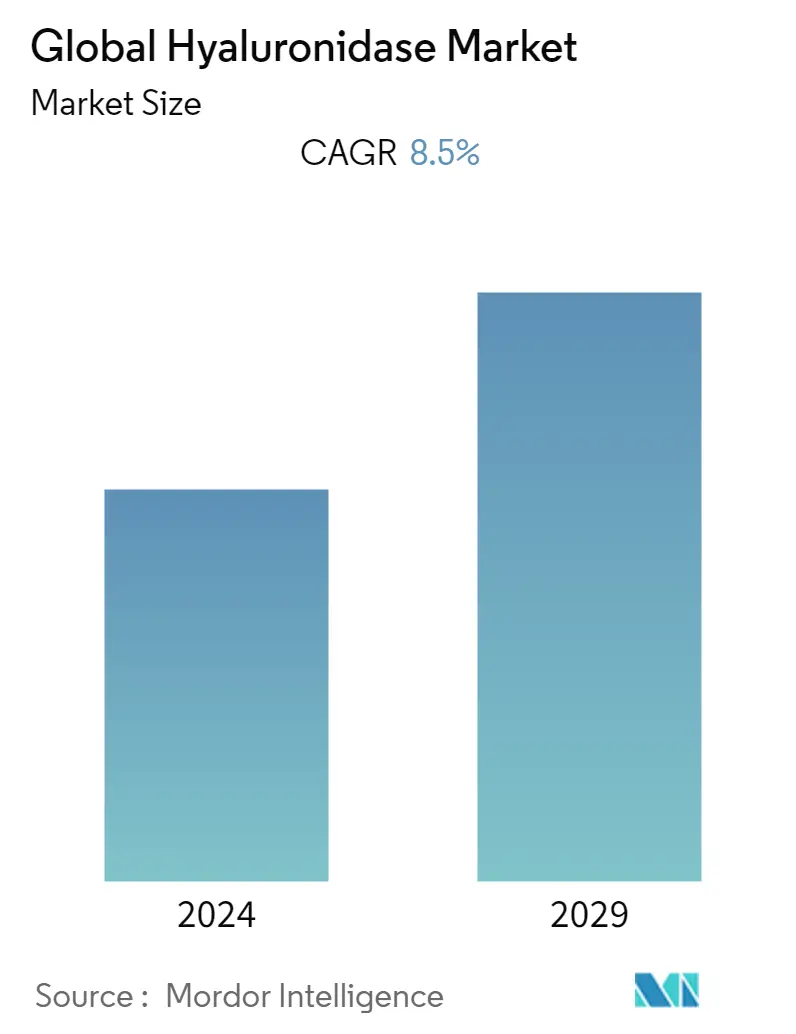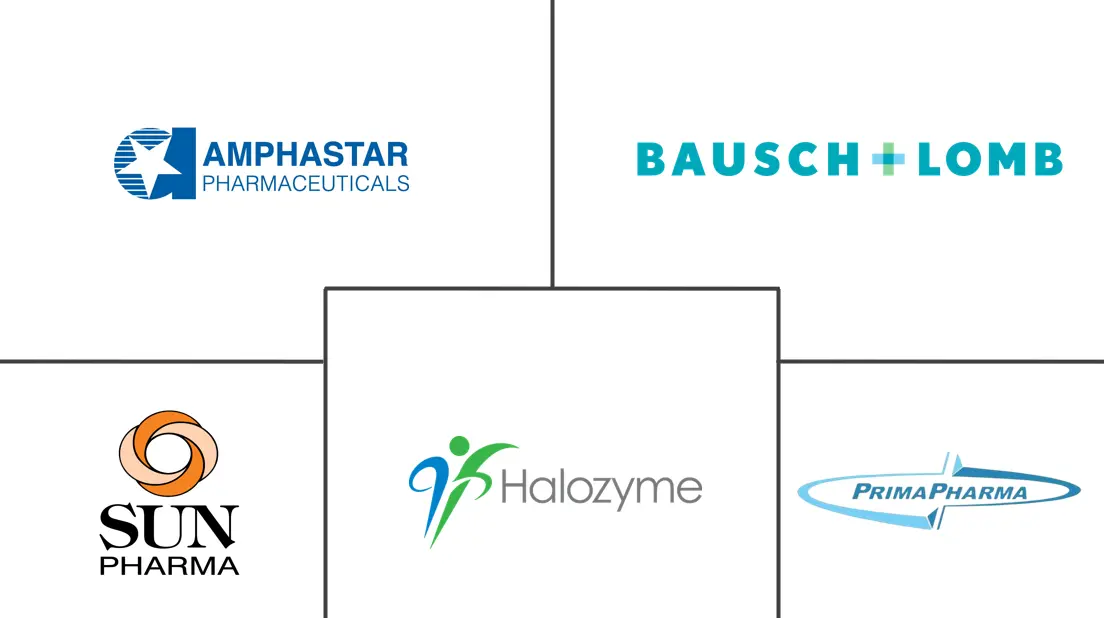Market Size of Global Hyaluronidase Industry

| Study Period | 2019 - 2029 |
| Base Year For Estimation | 2023 |
| CAGR | 8.50 % |
| Fastest Growing Market | Asia-Pacific |
| Largest Market | North America |
| Market Concentration | Medium |
Major Players
*Disclaimer: Major Players sorted in no particular order |
Hyaluronidase Market Analysis
During the time frame of the forecast, the hyaluronidase market is expected to register a CAGR of 8.5%.
The COVID-19 pandemic had a significant impact on the hyaluronidase market. For instance, a 2021 article by the British Association of Aesthetic Plastic Surgeons (BAAPS) stated that there was a 27% decrease in cosmetic surgical procedures in the previous year.Since most of the aesthetic surgical procedures utilize hyaluronidase, a decrease in aesthetic surgical procedures decreased the demand for hyaluronidase and thereby impacted the growth of the studied market. However, in the current scenario, it is anticipated that the resumption of surgical procedures due to the reduction of COVID-19 cases may increase the demand for hyaluronidase compared to the beginning of the pandemic. Thus, the studied market is expected to witness significant growth over the forecast period.
The studied market is growing because more and more correction procedures are using hyaluronidase and more and more people want minimally invasive cosmetic treatments.For example, a December 2022 article in the journal Aesthetic Plastic Surgery said that hyaluronidase therapy can fix fillers that were injected too much and also help dissolve subcutaneous nodules.Dermatologists can use Hyaluronidase to correct and reverse the effects of failed hyaluronic acid-based filler treatments.Thus, due to these benefits, the demand for hyaluronidase is constantly increasing, thereby driving the growth of the studied market.
The market is also growing because more and more people want cosmetic treatments that don't require a lot of surgery.For example, the American Society of Plastic Surgeons (ASPS) reported in February 2022 that 13,281,235 minimally invasive cosmetic procedures were done in the United States in 2020. Botulinum toxin remained the most popular procedure with 4.4 million procedures, followed by soft tissue filler (3.4 million) and laser skin resurfacing (997,245).The source also reported that the total minimally invasive cosmetic procedures performed on males and females in 2020 were 820,123 and 10,429,962, respectively. Thus, the adoption of minimally invasive procedures is increasing the demand for hyaluronidase.
Furthermore, there has been a surge in demand for cosmetic procedures worldwide in 2021. For instance, a survey conducted in 2021 by the Menarini Group, an Italian pharmaceutical company, among 100 dermatologists and plastic surgeons across India revealed that 65% of the respondents agreed that a facelift is the most sought-after facial aesthetic procedure in India, and 37% of the respondents have observed an increased demand for aesthetic procedures since the onset of the global COVID-19 pandemic, with the desire to look good on social media. Thus, there has been a rise in awareness among people about aesthetic procedures, which is increasing the demand for hyaluronidase and thereby driving the growth of the studied market.
So, the market is expected to grow a lot over the next few years because hyaluronidase is being used more and more in corrective procedures and because people want less invasive cosmetic treatments. But the bad effects of hyaluronidase could slow the growth of the market that was studied.
Hyaluronidase Industry Segmentation
Based on what the report is about, hyaluronidase is an enzyme that breaks down hyaluronic acid and makes connective tissues more permeable. These enzymes are widely used in aesthetic procedures. The hyaluronidase market is divided into three sections: type (animal-derived hyaluronidase, synthetic hyaluronidase), application (chemotherapy, in vitro fertilization, ophthalmology, dermatology, and other applications), and geography (North America, Europe, Asia-Pacific, the Middle East and Africa, and South America). The market report also covers the estimated market sizes and trends for 17 different countries across major regions globally. The report offers the value (in USD million) for the above segments.
| By Type | |
| Animal-Derived Hyaluronidase | |
| Synthetic Hyaluronidase |
| By Application | |
| Chemotherapy | |
| In Vitro Fertilization | |
| Ophthalmology | |
| Dermatology | |
| Others Applications |
| Geography | ||||||||
| ||||||||
| ||||||||
| ||||||||
| ||||||||
|
Global Hyaluronidase Market Size Summary
The hyaluronidase market is poised for substantial growth over the forecast period, driven by an increasing preference for minimally invasive cosmetic procedures and the rising demand for corrective treatments. The market experienced a temporary setback due to the COVID-19 pandemic, which led to a decline in cosmetic surgical procedures, thereby affecting the demand for hyaluronidase. However, as surgical procedures resume, the market is expected to recover and expand significantly. The growing awareness and desire for aesthetic enhancements, coupled with the ability of hyaluronidase to correct and reverse the effects of hyaluronic acid-based fillers, are key factors propelling market growth. The market is also witnessing a surge in demand for animal-based hyaluronidase, which is preferred over synthetic alternatives due to its perceived advantages.
North America is anticipated to hold a significant share of the global hyaluronidase market, supported by a robust healthcare infrastructure, a high number of cosmetic procedures, and the presence of major industry players. The region's market growth is further bolstered by the increasing adoption of advanced treatments and the rising prevalence of cosmetic surgeries. Additionally, the market is moderately competitive, with key players such as PrimaPharma, Amphastar Pharmaceuticals, and Bausch & Lomb leading the charge. The ongoing development and approval of new products and treatments, including those for autoimmune diseases, are expected to contribute to the market's expansion. Overall, the hyaluronidase market is set to grow, driven by its diverse applications and the increasing popularity of cosmetic and medical procedures.
Global Hyaluronidase Market Size - Table of Contents
-
1. MARKET DYNAMICS
-
1.1 Market Overview
-
1.2 Market Drivers
-
1.2.1 Increasing Penetration of Hyaluronidase in Correction Procedures
-
1.2.2 Rising Demand for Minimally Invasive Aesthetic Treatments
-
-
1.3 Market Restraints
-
1.3.1 Adverse Effects Associated With Hyaluronidases
-
-
1.4 Porter's Five Forces Analysis
-
1.4.1 Threat of New Entrants
-
1.4.2 Bargaining Power of Buyers/Consumers
-
1.4.3 Bargaining Power of Suppliers
-
1.4.4 Threat of Substitute Products
-
1.4.5 Intensity of Competitive Rivalry
-
-
-
2. MARKET SEGMENTATION (Market Size by Value - USD million)
-
2.1 By Type
-
2.1.1 Animal-Derived Hyaluronidase
-
2.1.2 Synthetic Hyaluronidase
-
-
2.2 By Application
-
2.2.1 Chemotherapy
-
2.2.2 In Vitro Fertilization
-
2.2.3 Ophthalmology
-
2.2.4 Dermatology
-
2.2.5 Others Applications
-
-
2.3 Geography
-
2.3.1 North America
-
2.3.1.1 United States
-
2.3.1.2 Canada
-
2.3.1.3 Mexico
-
-
2.3.2 Europe
-
2.3.2.1 Germany
-
2.3.2.2 United Kingdom
-
2.3.2.3 France
-
2.3.2.4 Italy
-
2.3.2.5 Spain
-
2.3.2.6 Rest of Europe
-
-
2.3.3 Asia-Pacific
-
2.3.3.1 China
-
2.3.3.2 Japan
-
2.3.3.3 India
-
2.3.3.4 Australia
-
2.3.3.5 South Korea
-
2.3.3.6 Rest of Asia-Pacific
-
-
2.3.4 Middle East and Africa
-
2.3.4.1 GCC
-
2.3.4.2 South Africa
-
2.3.4.3 Rest of Middle East and Africa
-
-
2.3.5 South America
-
2.3.5.1 Brazil
-
2.3.5.2 Argentina
-
2.3.5.3 Rest of South America
-
-
-
Global Hyaluronidase Market Size FAQs
What is the current Global Hyaluronidase Market size?
The Global Hyaluronidase Market is projected to register a CAGR of 8.5% during the forecast period (2024-2029)
Who are the key players in Global Hyaluronidase Market?
PrimaPharma, Inc, Amphastar Pharmaceuticals, Inc, Bausch & Lomb Incorporated, Halozyme, Inc. and Sun Pharmaceutical Industries Ltd are the major companies operating in the Global Hyaluronidase Market.

